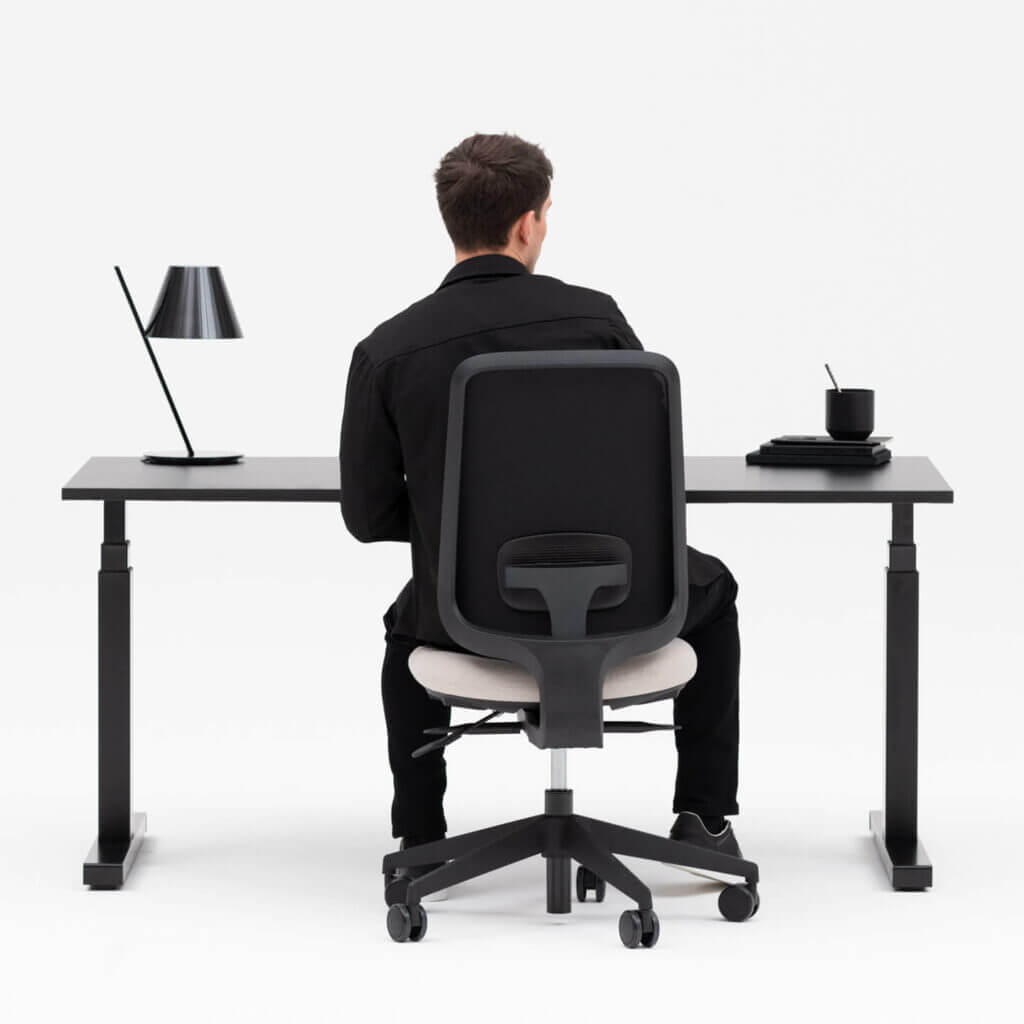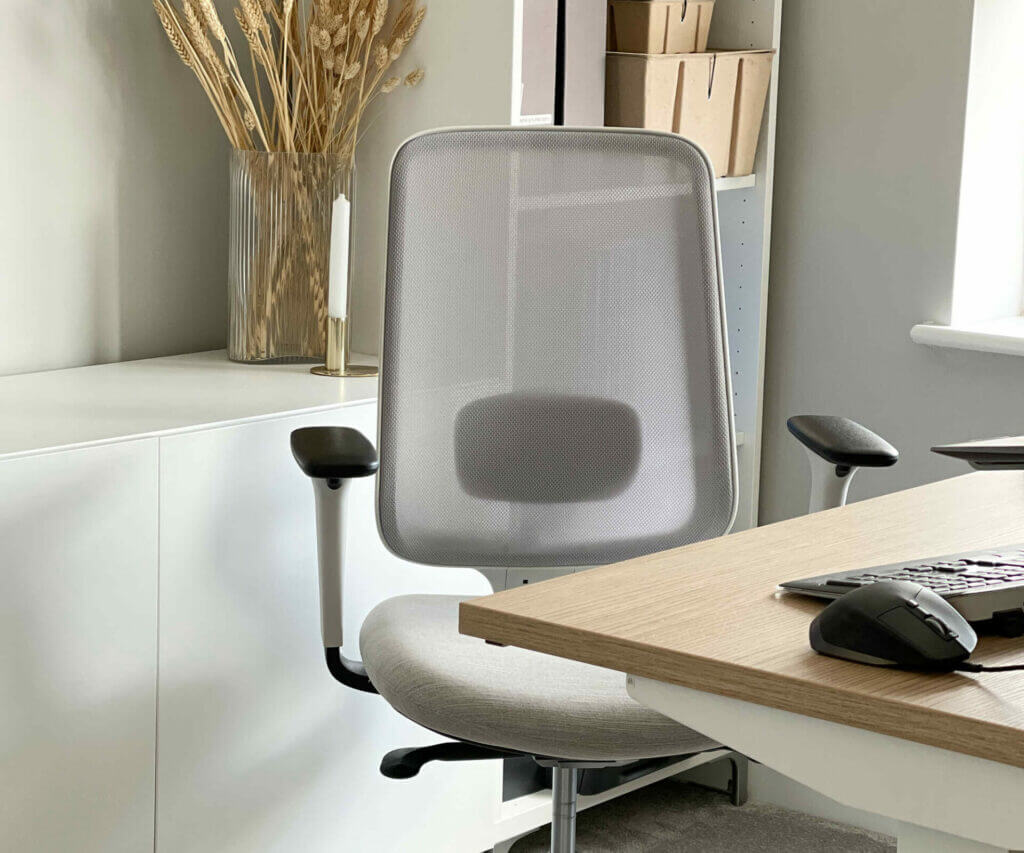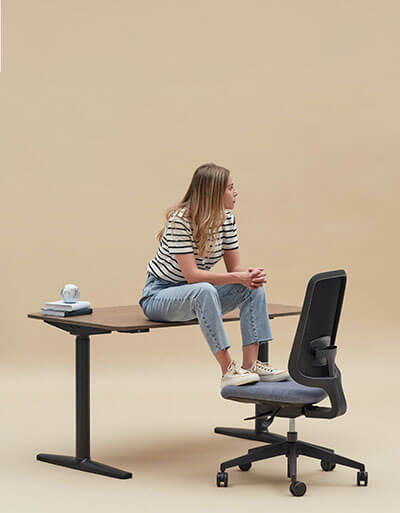Found yourself wondering how can health and safety in the workplace be improved by applying ergonomics?
Congratulations – that awareness that your office could be unergonomic is the first step in creating a workspace that’s better for your mind, body and personal safety. You see, many of us craft home offices with no regard for ergonomics and our bodies suffer as a consequence. And not only are they uncomfortable, they can actually be a health and safety hazard.
Once you know what good ergonomics is all about you can improve it in objects you use every day, like your office desk and chair. That’s exactly what we’re about to dive into in this guide.
Let’s talk ergonomics
First things first – what exactly is workplace ergonomics? In simple terms, ergonomics is about arranging our workspaces and tools to suit our bodies and the way we work. It’s about making our work environment comfortable and efficient, which helps prevent strain and injury.
Think about it. Have you ever experienced a stiff back, sore eyes or strained neck after a day’s work? When you’re working in the same uncomfortable positions day in and day out, those little pains and strains start to add up to an unsustainable way of working for your health.
Ergonomics means making adjustments to our working environment to put your body in the most sustainable and comfortable position possible. This can be big things, like your seating position, or small things like moving your monitor up an inch or two to be in your eyeline.
Imagine finishing your day feeling energised instead of sore and exhausted. That’s what ergonomics aims to achieve.

Improving workplace ergonomics doesn’t have to be complex
Don’t worry – we’re not suggesting you need to overhaul your entire workspace overnight. Small, incremental changes can make a big difference. Start by adjusting your office chair height, or try a new keyboard position. Pay attention to how your body feels and make tweaks accordingly.
Remember, ergonomics isn’t a one-size-fits-all solution. What works for your colleague might not work for you, and that’s perfectly fine. It’s all about finding what makes you comfortable and productive.
However, if you want to know the most impactful improvements you can make to your workplace ergonomics to safeguard your health and safety, keep reading.
Legal requirements for workplace ergonomics
You probably get the picture by now that workplace ergonomics is pretty important. In fact, it’s so crucial that employers have certain obligations to provide certain equipment and reasonable adjustments.
Most of these legal requirements stem from two particular pieces of legislation: Health and Safety at Work etc. Act 1974 and the Display Screen Equipment (DSE) Regulations 1992 (amended in 2002).
Let’s explore the specific legal requirements for ergonomics from this legislation and how they can impact your health and safety.
5 legally required ergonomic changes to improve your health and safety
In answer to the question ‘how can health and safety in the workplace be improved by applying ergonomics?’ We’d suggest taking in the below requirements for employers.
All of them are designed to have specific positive ergonomic effects. Keep reading to find out what they are.
1. Workstation assessment
Employer’s requirement: Conduct risk assessments of workstations, particularly for display screen equipment (DSE) users.
What this entails: Evaluating screen positions, desk setup, chair ergonomics, lighting and other environmental factors. For remote workers, this may be completed through virtual assessments or checklists.
Intended ergonomic impact on health and safety: To identify potential ergonomic hazards which can then be prevented or reduced. For instance, musculoskeletal disorders from chairs without lumbar support or visual fatigue from screens which are set up poorly.
2. Health and safety training
Employer’s requirement: Provide health and safety training to employees using display screen equipment.
What this entails: Education on subjects like proper posture, equipment adjustments and potential health risks. This includes useful advice on health and safety around screen use such as education on how far away a screen should be from your eyes.
Intended ergonomic impact on health and safety: To empower employees to have good ergonomic practices in their daily working lives. In turn, this aims to reduce the risk of developing work-related health problems from poor workplace ergonomics when using display screen equipment (aka. laptops and computer monitors.)
3. Eye tests and glasses
Employer’s requirement: Provide eye tests on request and contribute to the cost of glasses if needed for work with screens.
What this entails: Arranging eye tests and providing basic glasses or a contribution towards glasses.
Intended ergonomic impact on health and safety: To help employees see their screens clearly without squinting or straining. This can also help reduce headaches and eye soreness from staring at screens all day.
4. Breaks
Employer’s requirement: To plan work to include periodic breaks or changes of activity for DSE users.
What this entails: Structuring work to allow short, frequent breaks and encouraging task variation.
Intended ergonomic impact on health and safety: Encouraging employees who spend most of their working days at desks to move around and switch things up during the day. This in turn can help relieve back pain and fatigue.
5. Adjustable office furniture
Employer’s requirement: To provide adjustable chairs and if necessary footrests in the company office. This doesn’t currently extend to home working but many employers choose to make a contribution towards home working equipment to keep their staff in ergonomic comfort.
What this entails: Employers must supply office chairs with adjustable features, footrests and desks at appropriate heights.
Intended ergonomic impact on health and safety: To allow employees to work at an ergonomic workstation to keep nagging aches and pains at bay.
Need ergonomic office chairs?
We’d suggest investing in a Slouch chair – as we’ve specifically designed our office chairs to have adjustable height and lumbar support, making them a comfortable and supportive sit all day long.
If you’re responsible for providing office equipment to employees, simply fill out this contact form to find out more about buying in bulk.

Make your home office truly ergonomic
Now that you know how health and safety in the workplace can be improved by applying ergonomics, you’ll be that much more equipped to take on the day in comfort.
Whether you’re an employer looking to meet legal requirements or an employee wanting to create a more comfortable workspace, ergonomic improvements can make a world of difference. Invest in office furniture today that makes your workplace ergonomics a dream come true.
For answers to any burning questions, get in touch with us at [email protected].

